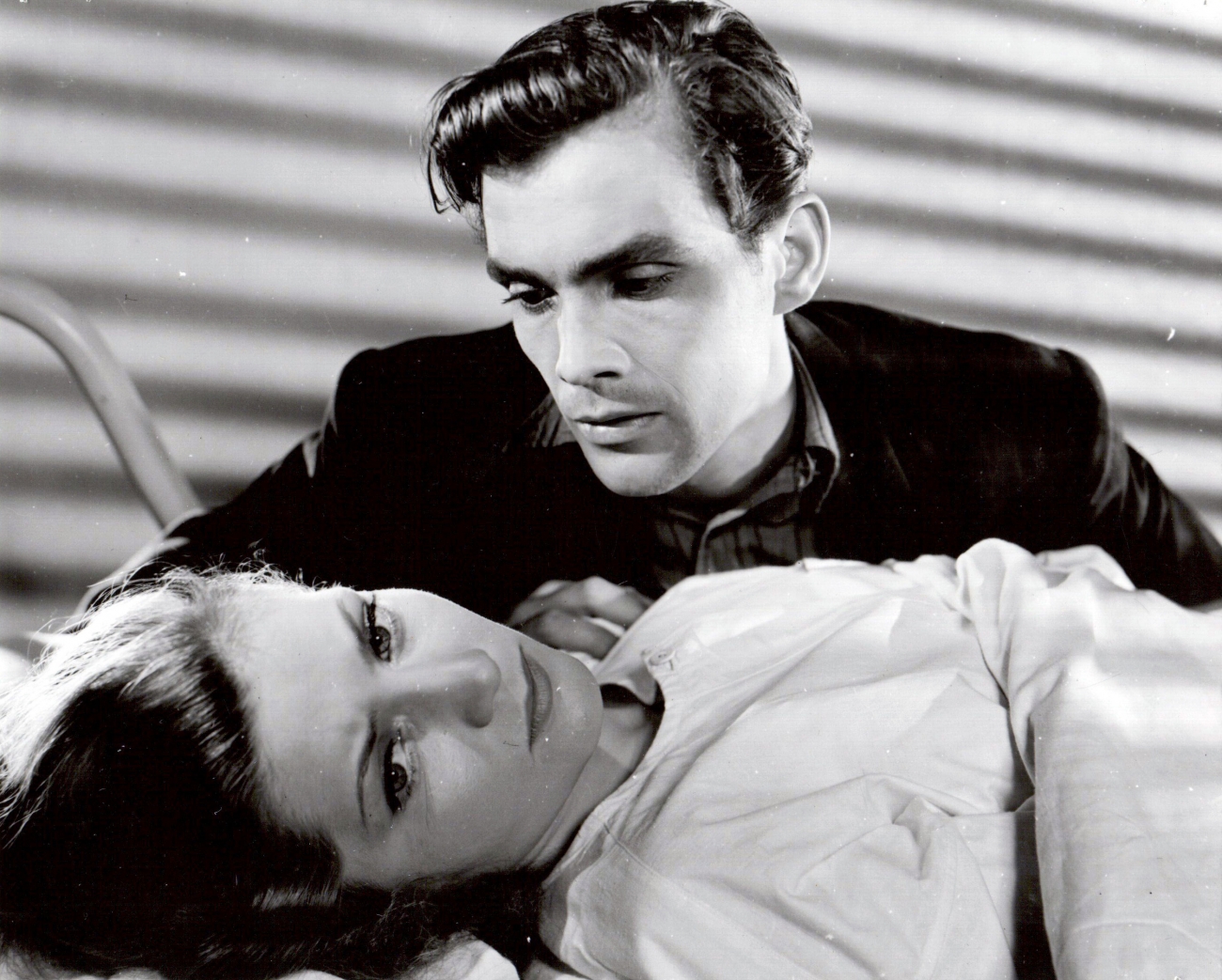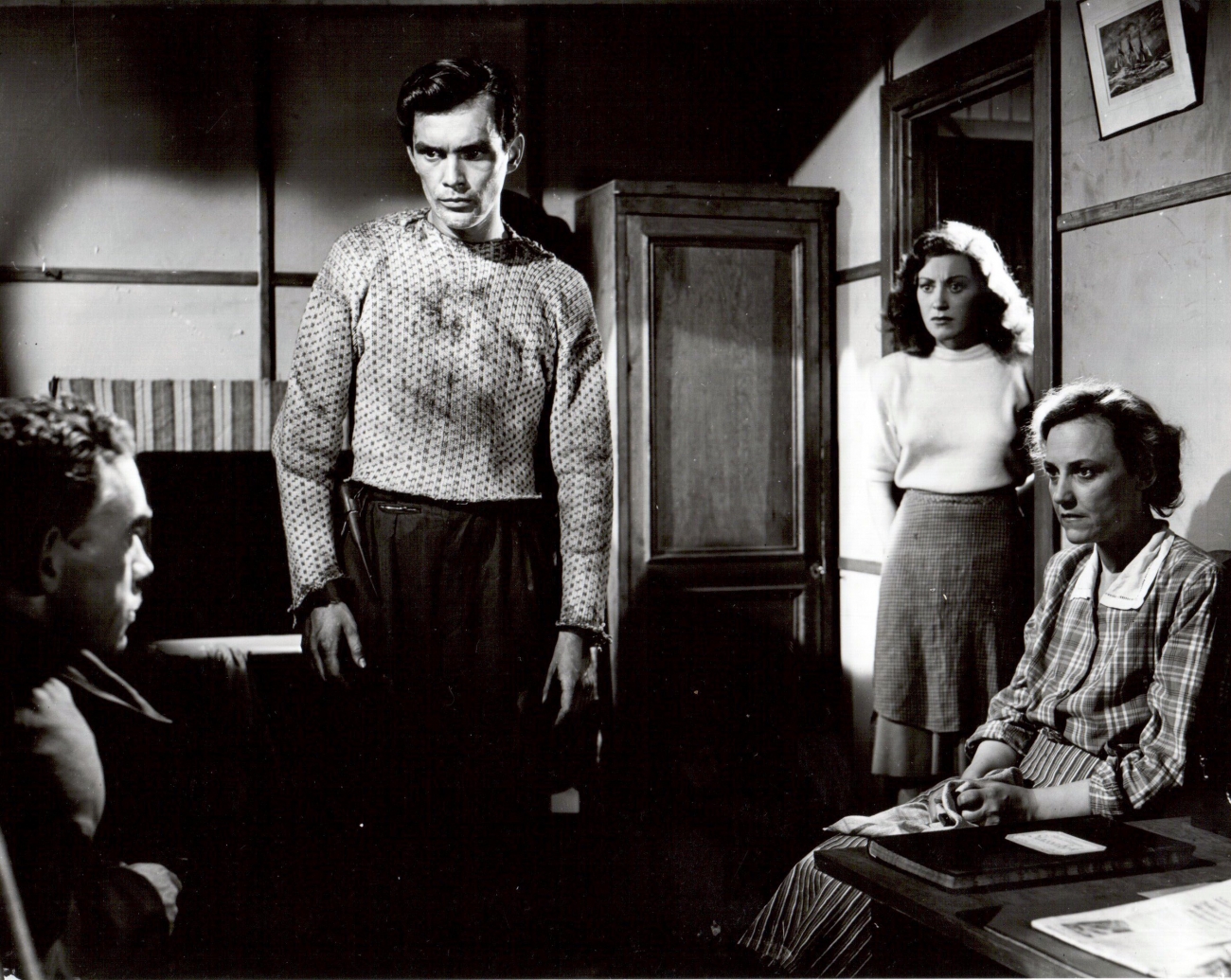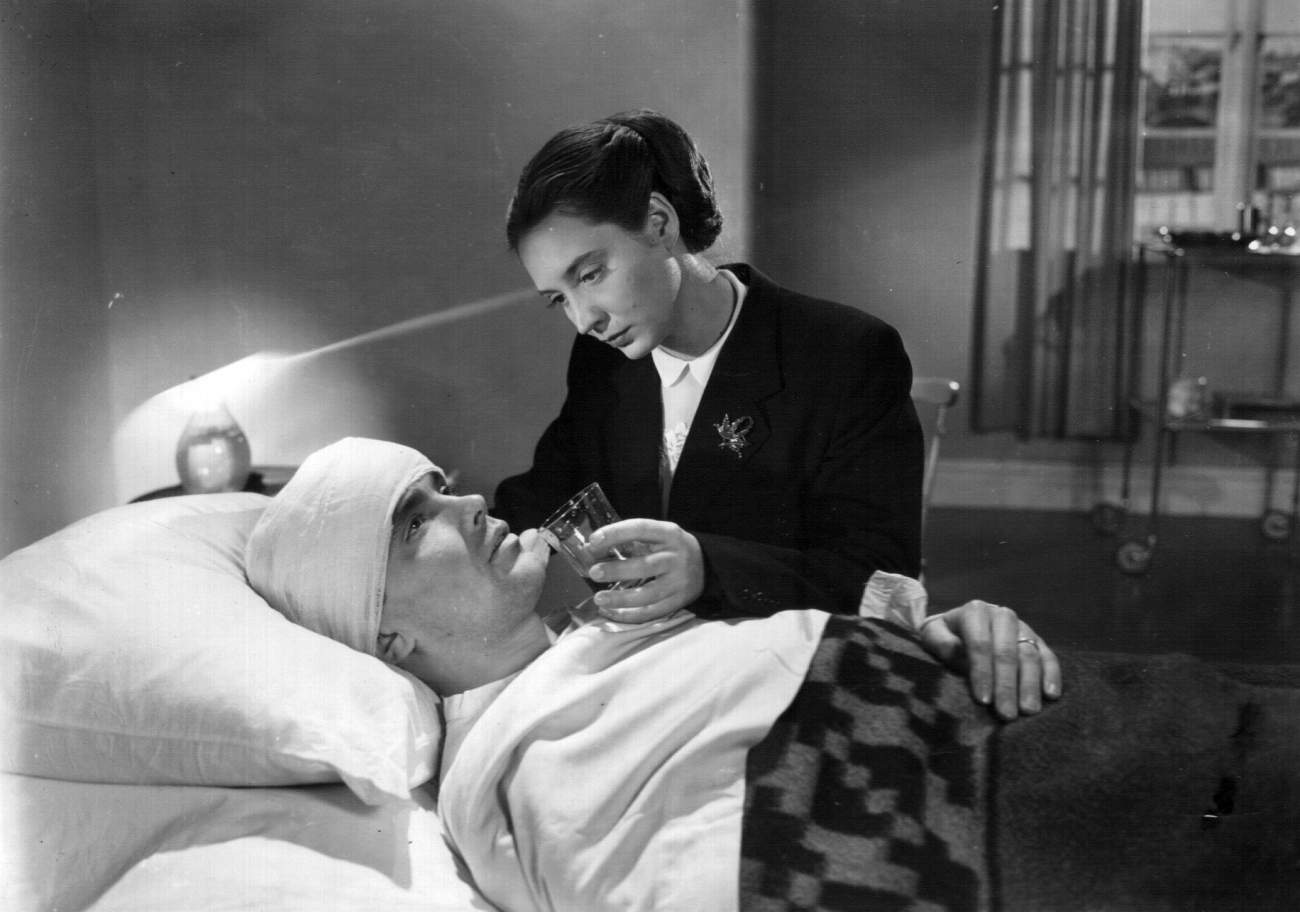Bergman's Early Romantic Films
Three of Bergman's early black and white films from the late 1940s shown recently at PFA in their intimate small theater.
-
 Det regnar pa var karlek - Ingrid and David awaiting birth. Photo: www.ingmarbergman.se
Det regnar pa var karlek - Ingrid and David awaiting birth. Photo: www.ingmarbergman.se -
-
During this Bergman centennial year, the Pacific Film Archive showed these three films in succession at www.bampfa.org.
The films were “It Rains on Our Love” (1946), “A Ship Bound for India” (1947), and “Music in the Dark” (1948). All of these early Bergman films are romantic fairy tales, involving young couples confronting the cruelty, indifference and stultifying bureaucracy of society. -
 Skepp till India land - Aboard the salvage sloop (L-R): Captain, Johannes, Sally, and Alice. Photo: www.ingmarbergman.se
Skepp till India land - Aboard the salvage sloop (L-R): Captain, Johannes, Sally, and Alice. Photo: www.ingmarbergman.se -
-
Lorens Marmstedt (whom the Bergman Foundation identifies as “an enterprising and audacious film and theater producer, who had a profound influence on the young Ingmar Bergman”) urged Bergman to make the last of the three “if he cared to continue as a movie director.” It allowed him to really hone his craft.
“Music in the Dark” was adapted by Bergman and author Dagmar Edqvist, from her 1946 novel “Music in Darkness” as a necessary success to follow his previous two films. All three films star Birger Malmsten and were produced by Lorens Marmstedt. Birger, a very handsome leading man, certainly would have been admired in the U.S. and it is curious that he did not remain in Bergman’s troupe. In each movie he falls in love with a young girl and struggles to offer her a new, happy life together.
Not having seen any of these early films before, I was surprised to see from this “dark master” three films emphasizing the vital aspect of love, companionship and even neighborliness. For a man who held this aspect in highest regard, it is interesting that he exhausted so many wives and mistresses trying to find love while he battled his own demons. -
 Ingrid continues to visit Bengt. Photo: www.ingmarbergman.se
Ingrid continues to visit Bengt. Photo: www.ingmarbergman.se -
It Rains on Our love (Det regnar på vår kärlek, 1946)
“Rains” contains a fairy godfather (Gösta Cederlund). Somewhat like Mary Poppins, he typically appears with an umbrella and is merely known as “the man with the umbrella.” He introduces himself at the end of the first scene as an avuncular observer, one who knows much more about the characters and their fate than they do themselves. Periodically he appears, often as a commentator or in a minor role aware of their circumstances, but finally he takes a decisive role that confronts the social powers with the truth they have not acknowledged.
The film begins with two people — David (Malmsten) and Maggi (Barbro Kollberg) — missing a train and having to wait in a train station, where they get to know one another and ultimately leave to share a hotel room. We learn he has just been released from prison for a minor offense; she is pregnant and leaving town to start a new life.
They get caught in the rain and Maggi twists her ankle. Seeking shelter, they break into a cottage to escape the storm. Sheriffs’ agents come to haul away David, but he is rescued by the “godfather.” Later an obsequious man claiming the cottage is his, allows them to rent it; so, David gets a menial job to pay the rent. This same shyster later sells them the cottage under severe terms only to later buy it back from them, revealing he is selling it for considerably more money to a developer. They end up in court but are eventually setting off again as the perfect young couple in love. -
Observations
In the retrospective of Bergman’s later films it’s interesting to notice how important (young) love is for independent youth against social apathy, which more typically places obstacles in the way of those who do not conform than aid the young couple to become included and improve the society. -
A Ship Bound for India (Skepp till India land, 1947)
The second film is more malicious. In “India,” Johannes Blom (Malmsten) is the only son of naval salvage Captain Blom and his wife, Alice. Captain Blom hates his son because he is slightly disfigured with a humped shoulder - which does not affect his strength, work ethic or intelligence. The captain lives with but is estranged from his wife, who bears all that he does to her. Alice loves her son, pities him and his father’s cruelty to him, and tries to protect him. Johannes is determined to make something of himself and his naval knowledge and wishes to sign onto a merchant marine vessel for any ports far from home.
Captain Blom has a reputation as a handsome, bellicose man who insists on being respected. He is a regular at the theater and at his young mistress Sally’s (Gertrud Fridh) vaudeville show — and living quarters — for nights at a time; he evidently ignores his business and his laborers in salvaging a sinking ship.
Eventually the captain cheats a laborer and dockside laborers turn against their boss. They confront him in the theater, beating him until he escapes to Sally’s quarters above the theater. Her residence has a collection of his tropical mementos, indicating he has lived with her for some time. Now he discovers the blows to his head have worsened an existing eye condition and he will soon be blind.
He brings his whore on board his houseboat, giving her his son’s room. After an awkward start between the two young people, the girl prefers the son to the father. Escaping for an afternoon on an island, they fall in love. She is not repulsed by his defect; she truly respects his character and loves him. When they return to the boat, the father discovers them together and strikes his son. This time Johannes doesn’t cower, but in the presence of his new love he strikes back, twice.
In his father’s absence, at the urging of several men in the crew, Johannes takes over to salvage the ship and help the crew earn their wages. At a meal together with the family and the girlfriend, it is apparent the members of the crew are utterly contemptuous of the captain but only remain on the job for their wages.
At the end of this family story, Sally tells the captain she will escape her current circumstances with the son. And when the crew can’t handle salvaging the ship, Johannes volunteers to finish the job in an old-fashioned diving suit with a watertight metal helmet and viewing port. The crew has left and somehow only the father remains atop to continually pump air into his son’s helmet, his sole life-support system. The father stops pumping, throws the guide rope overboard, and escapes in a rowboat. The mother witnesses this and yells for help, and somehow Johannes is rescued. Sally dashes in to help, too.
Now nearly blind, the captain returns to his love nest above the theater, where he wreaks havoc, damaging everything. The son and mother (who knew nothing about this hideaway) arrive with the police and try to calm the father to accompany the officials who can help him. He gets away from them, breaks a window and jumps out. -
A story within a story
This whole biopic is framed at both the beginning and end with another story. The film begins with Johannes having returned after seven years abroad. Now he is an officer. Walking down a lamp-lit street, he seems to recognize Sally ahead of him. He calls to her only to recognize that it is not his sweetheart. “That’s a shame,” the girl replies as she departs, for he is handsome in his ship’s uniform, not hunched with his hump, as he had been as a youngster.
Later Johannes is outside a tavern watching a party inside, and an older woman recognizes him and invites him back to her home for coffee. They chat at the table remembering good old times, with his back to a bedroom door, but a younger woman yells from another room and slams the door.
He recognizes the voice of his sweetheart whom he had returned to find. The landlady says she confines herself to the room and is angry at the world. He confronts his beloved in her room. He says he’s returned to redeem his promise, when they parted, to rescue her and live a better life together. But she tells him to leave, that she doesn’t want to go. He wanders the seashore and falls asleep on the sand, setting the scene for the dream that is the plot of the film.
The concluding frame has the son return to the boarding house where his love resides. Now he persists as they argue with each other. Sally barricades herself in the bathroom, and Johannes knocks down the door and persuades her until she can no longer resist. They return to the ship together, sailing off toward a new life together. -
Observations
The plot devices in this movie show Bergman moving from gifted apprentice toward master craftsman. It is of particular interest that he uses framing to introduce the real story in the middle, explain the first part of the film and justify the final one. He will use this device, even more accomplishedly, in other films. -
Music in the Dark (Musik i mörkret, 1948)
This film begins with one of the most startling and sympathetic images of any Bergman film: Bengt Vyldeke, a talented musician (Malmsten evidently really played the piano in this film), is accidentally shot in the head while trying to rescue a puppy during military target practice, blinding him for life. His girlfriend and other friends abandon him. He is despondent for his future.
His family’s young maid Ingrid (Mai Zetterling), mentions to Bengt’s mother that her father has just died and she needs a musician for his meager funeral, attended only by her. Reluctantly, Bengt plays the church organ, revealing his true talent, a favor for which the girl is forever grateful. She has noticed he is frustrated, particularly because he’s not able to read; so, she reads to him and even learns Braille. They greatly appreciate each other’s company, and these sessions educate Ingrid well beyond her station. Ingrid overhears a careless word to his sister’s suggestion that Bengt should marry the maid, and they separate, driving the plot.
After Bengt is rejected for a conservatory admission (one suspects because of his blindness), he leads a menial life with few prospects, though he learns to adjust to his handicap at a center for the blind. There he teaches blind pupils music and piano, and accepts a position as piano tuner.
Some time later, he is alone in the woods and overhears a woman speaking with friends; he recognizes Ingrid’s voice. They meet, and Ingrid explains she is studying at the university to become a teacher and has a boyfriend who needs to learn both French and music. Bengt offers to tutor them.
The tutoring sessions become strained, yet Ingrid evidently continues to visit Bengt, and even invites him to escort her to her college ball. He declines but in desperation later tries to attend the ball on that night. He is denied entrance and wanders away, knowing he lost the one girl he really loves and admires. He goes to a bridge where he contemplates suicide.
Sensing something’s amiss, Ingrid leaves the ball and her boyfriend and goes outside looking for Bengt. She finds him on the bridge, and there they discover their true love. But the movie does not end there. They return to the parish minister asking to be married. Because she is evidently still a minor and because she was an orphan, the minister was appointed her guardian — and is not willing to marry them. He thinks their love is infatuation and fears for how they will earn a living.
He finally relents and agrees to marry them, in the small chapel where Ingrid’s father’s funeral was held. A reception is held, and then with all good wishes, they depart and the last scene sees them on a train bound for a happy and fulfilling life together. -
Observations
Here physical blindness is the symbol of individual, religious and social resistance to the fated love of a young couple, much as in “Rain” and in “India” other circumstances had initially thwarted young love, only to be overcome. As simplistic as these early films might be, they would certainly have appealed to the common viewer while also allowing Bergman to hone his craft, by writing, directing actors and crew, and experimenting with lighting and facial shots, which would become a hallmark of his work.
In all film, facial expressions and gestures or actions are the signs of emotion, intellect and maturity. But Bergman is utterly intrigued with the face and with the mastery of actors to act their characters. With that kind of focus, actor and director must have exquisite trust in each other to carry the burden of the film. Restraint is as important as consummate release of the emotion.
In “Music,” both characters are not merely wholesome but intelligent, though it takes time to recognize their true love for one another. Family, society, school and religion each take a whack at these main characters. Our distance from these films — more than a half-century removed — should make us appreciate how perennial these themes are, which is why they occur in so many movies and plays, and why audiences adore them. -
Romance
All three of these films are love stories. It is interesting to see this as the theme in some of the director’s earliest films, in some of his latest, as well as throughout his work. Too frequently people focus upon his choice in how he tells a particular story or the fantastic tales he tells. Granted most film devotees will give him his due for his technical prowess: for staging his scenes, directing his actors, for gathering about him such a team of superb actors and crew devoted to telling his stories. While many of his actors performed for others in their productions, they were often devoted to Bergman, his art, his skill and his vision. Too often, however, the critical reputation among occasional Bergman viewers is of the bizarre plots, rather than upon the significant meaning and his use of symbolism.
Regardless of the messages of these simple romances, they are even more important as exercises for Bergman to hone his skills. While not original with Bergman, the initial shot of walking off the ship, through the shipyard, and following the girl down the deserted street, become stereotypical in later noir films, but these are opportunities to play with darkness and especially shadows that Bergman is perfecting. The confrontation scenes all show how Bergman is helping us focus on pairs of people, even in a melee.
These three films were produced before Bergman was shooting color, and the viewer may appreciate even more that the characters are morally black or white, too. It is fortunate that Bergman schooled himself in monochromatic films, since shadows, gradations of light and full sunlight are so important to him, whether indoors or out, throughout his cinematic history. -
Ted Olsson
-
-
